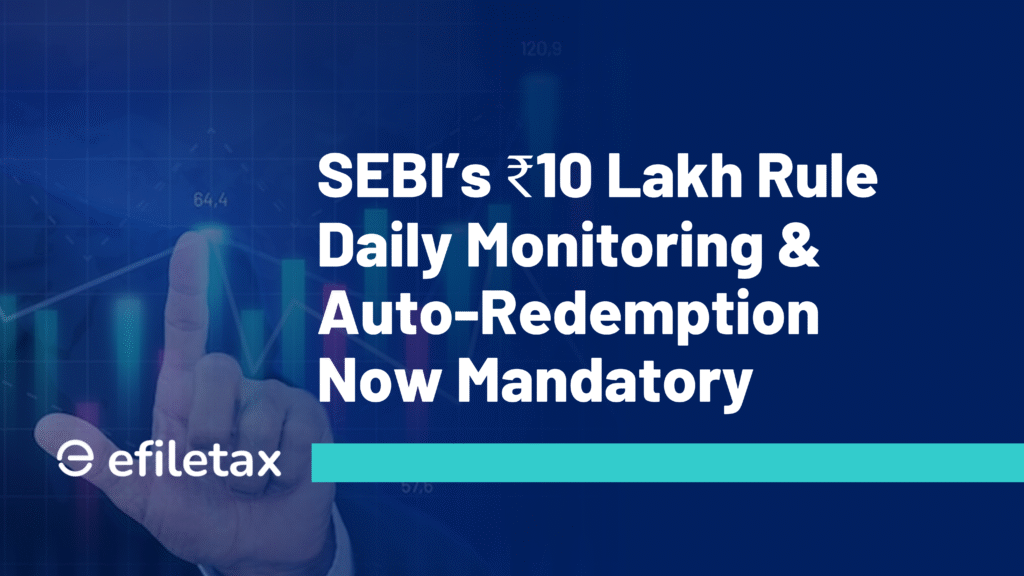
SEBI Rule on ₹10 Lakh Minimum in Investment Funds
SEBI has introduced a key compliance rule mandating daily monitoring and auto-redemption when the ₹10 lakh minimum investment threshold in Specialized Investment Funds is breached. This move aims to protect retail investors and ensure only high-net-worth individuals enter risk-heavy fund categories.
What Are Specialized Investment Funds?
Specialized Investment Funds include the following:
- Category I & II Alternative Investment Funds (AIFs)
- Mutual fund schemes with a high-risk strategy (such as hedge-style funds)
- Schemes under SEBI’s High-Risk Category, including strategically complex or illiquid funds
These funds are subject to tighter investor eligibility norms due to their risk profile.
New SEBI Rule: Key Highlights
| Particular | SEBI Mandate (July 2025) |
|---|---|
| Minimum Investment Threshold | ₹10 lakh |
| Daily Monitoring | Mandatory for AMC / Fund Manager |
| Auto-Redemption Trigger | If investment value falls below ₹10 lakh (other than due to market movement) |
| Exemption | Breach due to market fluctuation does not trigger auto-redemption |
| Implementation | Effective for all new and existing investors in such funds |
| Monitoring Period | Daily end-of-day NAV monitoring for compliance |
Why Has SEBI Introduced This Rule?
The ₹10 lakh minimum was already applicable as an entry barrier. But now, SEBI wants continued compliance post-entry too.
Key reasons:
- Retail investor protection – prevent low-cap investors from unintended high-risk exposure.
- Standardisation – consistent rules across all funds of similar risk.
- Operational discipline – fund houses must now build tech/process to monitor breaches daily.
Focus Keyphrase Subheading: ₹10 Lakh Minimum Investment Rule
This ₹10 lakh minimum investment rule applies not just at the time of subscription but throughout the holding period. Any voluntary withdrawal by the investor that breaches the limit will lead to mandatory auto-redemption of the entire investment.
This is applicable regardless of the remaining holding value.
What Should Investors Do Now?
Here’s a quick guide for investors already in or entering such funds:
- ✅ Track your redemptions – Don’t let partial exits pull your value below ₹10 lakh.
- ✅ Plan SIPs wisely – Top-ups should ensure post-deduction balance remains compliant.
- ❌ Don’t assume market dip is a breach – Only investor-initiated actions count.
Expert View: A Wake-up Call for Lazy Portfolios
According to leading portfolio advisors, this SEBI rule pushes investors to:
- Stay alert on fund limits
- Refrain from casual exits that may force liquidation
- Avoid passive tracking once minimum investment is done
This rule promotes a serious investor mindset, suitable for high-risk strategies.
Legal Reference
- SEBI Circular SEBI/HO/IMD/IMD-I DOF3/P/CIR/2025/xx dated July 2025
- Issued under powers granted by SEBI (Mutual Funds) Regulations, 1996
For official document: sebi.gov.in
Internal Link Tip
Also read: What Are Alternative Investment Funds? – Efiletax Guide
Summary
SEBI now mandates daily monitoring of ₹10 lakh minimum investment in specialized funds. Breaches (other than market dips) trigger full auto-redemption. Learn how this affects AIFs, high-risk mutual funds, and investor strategy.
FAQs on SEBI ₹10 Lakh Rule
Q1. Does this apply to regular equity mutual funds?
No. This rule is limited to select high-risk categories like AIFs and specified strategic schemes.
Q2. Will my fund auto-redeem if market crashes below ₹10 lakh?
No. Only investor-driven actions that reduce the value below ₹10 lakh will trigger redemption.
Q3. Can I re-invest after redemption?
Yes, but you must again invest ₹10 lakh or more to re-enter.